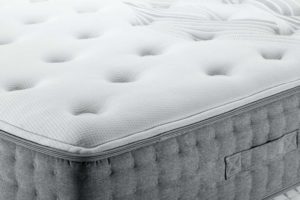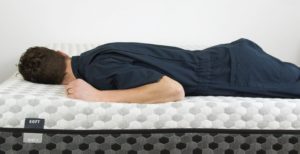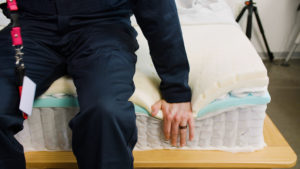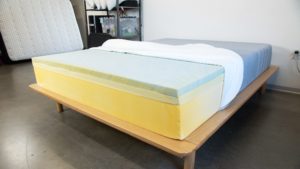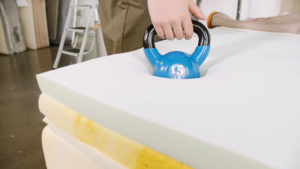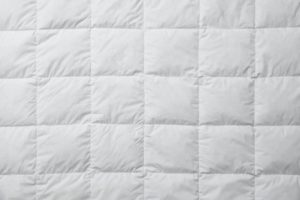Pillow Research Methodology
The Sleep Foundation team personally tests the products we feature in our reviews and guides. For each product category, we rely on a complex testing methodology that integrates the criteria that matter most to sleepers. Our pillow tests incorporate objective and subjective feedback for well-rounded performance insight.
We test and rate pillows based on a handful of factors. Our team members take turns lying on each pillow in different positions to evaluate support and conforming. We also physically handle the pillows to test for moldability and shape retention, and we use thermal sensors to monitor heat buildup. Other performance areas we assess include odor potential and ease of cleaning. This comprehensive system allows us to recommend the best pillows to our readers.
We’ll take a deep dive into our pillow testing process. We’ll cover important qualities to look for when shopping for a new pillow and explain each performance category our testers take into account.
Why You Should Trust Us
Each member of the Sleep Foundation testing team brings years of experience and expertise to our hands-on product evaluations. Our team consists of people who fall into different categories based on sleep position and body type. This diversity allows us to make pillow recommendations that are inclusive of all sleeper types.
We also regularly revisit the top picks on each page, occasionally adjusting our rankings based on recent tests or product improvements.
Our Pillow Research and Testing
Our team conducts all pillow tests in our lab located at our Seattle headquarters. These tests consist of multiple stages during which our testers lie on each pillow and perform a series of hands-on tests to evaluate qualities like moldability and conforming. Some of our assessments involve technological implements, such as thermal sensors for testing temperature control and a VOC meter to evaluate odor potential.
We take measures to standardize our tests and limit external factors that could otherwise sway our ratings. These include using each pillow on the same mattress and maintaining a consistent temperature in our lab. Each stage of testing also involves multiple team members to elicit feedback from people of different body types and sleep position preferences.

How Do You Know a Pillow Is Right for You?
Your pillow plays as much a role in your overall sleep quality as your mattress. We typically recommend mattresses based on criteria like sleep position or body type, whereas our testing has shown the best pillow for any given sleeper is often based more on personal preferences. As long as a pillow meets your basic needs and complements your existing mattress, it should provide adequate comfort night after night. The main factors to consider when choosing a new pillow include:
- Support: A pillow should provide enough loft to keep your head and neck properly aligned with the rest of your spine. Your ideal support level depends on which sleep position you favor. We’ll cover unique considerations for each position below.
- Firmness: A pillow that feels too soft may sink excessively and leave you with neck and shoulder pain, but an overly firm pillow can also lead to discomfort. Many people prefer a happy medium with gentle cushioning and an even surface for your head.
- Shape: Most people are familiar with the classic rectangular design for pillows, but today’s models come in a wide range of shapes. Some people enjoy these non-traditional shapes, while others prefer the tried-and-true design.
- Breathability: Core and cover materials both play a role in how well a pillow regulates temperature. If these materials retain heat, you may wake up feeling excessively warm or stuffy.
- Feel: Does the pillow itself feel right to you when you lay on it? Pillows are available in a variety of materials, both inside and out, so it’s important to find a combination that feels right to you. A pillow may meet all your other needs, but if you don’t like the way it feels, you won’t like laying on it.
Pillows, Mattresses, and Sleeping Position
During our pillow tests, we’ve noticed a strong connection between how comfortable a pillow feels and the mattress firmness. On a soft mattress, your body sinks more deeply into the surface. This places the mattress closer to your head and neck, so you don’t need as much pillow loft. In contrast, a firmer mattress leaves a larger gap between your head and the mattress surface. You may need a thicker, fuller pillow if you sleep on a firm mattress.
Sleep position compounds this issue. People who sleep on their sides generally need a thicker pillow to fill the space between their heads and shoulders. Back sleepers don’t need as much loft as side sleepers, but the pillow should be thick enough to keep the head elevated. Otherwise, you may be more likely to snore or develop neck pain. For stomach sleepers, thin pillows are usually most comfortable. Too much lift can create neck pressure due to uneven alignment. Some stomach sleepers prefer not to use any pillow whatsoever.
Pillow Loft
Loft refers to the pillow thickness, which relates somewhat to support. Your pillow is likely to sink beneath the weight of your head, so we grade loft based on the total thickness when the pillow is not compressed. Our team uses three loft categories:
- Low: Less than 3 inches
- Medium: 3 to 5 inches
- High: More than 5 inches
Your sleep position and body type should guide which pillow loft you choose. A low-loft pillow provides some cushioning for the head and neck but not much lift. Stomach sleepers and individuals with softer mattresses often prefer this option. A medium-loft pillow is good for back sleepers and combination sleepers with a mid-range mattress firmness. The extra height of high-loft pillows is popular with side sleepers and individuals with larger heads.
Some pillows are designed for adjustable loft, allowing you to add or remove fill to make the pillow thicker or thinner. These pillows typically contain shredded memory foam or latex, buckwheat hulls, or other materials that allow you to customize the loft to a specific thickness. People who switch between sleep positions tend to benefit the most from adjustable loft pillows, as do sleepers whose loft preferences change from night to night.
If you’re not sure what pillow loft you need, we recommend starting with an adjustable pillow so you have the room to find the right height for you.
Pillow Firmness and Support
Like mattresses, our team assigns firmness levels to pillows. However, pillows use a more relaxed rating system. Rather than using a 10-point firmness scale, we use more general categories, including soft, medium, firm, and adjustable.
Support is the most important consideration when we determine the firmness rating. During our tests, we evaluate how well a pillow maintains an even surface and resists compression. Soft and medium pillows typically sink beneath our weight, and firmer pillows push back against our heads.
Fill composition also helps us determine pillow firmness. Some fill materials are inherently firmer or softer than others. For example, buckwheat hulls tend to make pillows feel firm or extra firm, while pillows containing down and feathers usually feel soft or extra soft. Other materials, such as memory foam and latex, can be softer or firmer depending on their formulations.
While the fill material can dictate how soft or firm the pillow feels, the fill level plays a role in its overall supportiveness. For instance, a down pillow with a high fill power may simultaneously feel plush and supportive.
Additionally, we test many pillows that are not necessarily intended to support your head. These include knee pillows, wedge pillows, and body pillows. Our criteria remains the same for these pillows, but we take their intended use into account for our ratings.
Pillow Feel
Every fill material has a distinct feel that appeals to some people. You may prefer the squishy cradling of memory foam, the gentle responsiveness of latex, the exceptionally firm support of buckwheat hulls, or the cloud-like softness of down, feathers, or down alternative.
Determining which pillow feel you prefer may require some trial and error. If you’re shopping in a store, gently compressing the pillows can give you an idea of what you might like. With online shopping, many companies offer sleep trials. These policies allow you to test out the pillow in your home, typically for 30 to 100 nights, and return the pillow if you’re not satisfied, though return shipping fees may apply.
Our Performance Criteria
Each pillow we analyze undergoes the same testing process to assess key criteria. For every test, our team members assign one of five ratings:
- Poor
- Fair
- Good
- Very Good
- Excellent
After each stage of testing, we aggregate these ratings and generate an average that reflects feedback from all testers.
Our ratings are not set in stone. We frequently revisit our guides and retest pillows to ensure our ratings are accurate and current. If we notice disparities, we adjust the ratings accordingly.
Durability
Durability is how well a pillow holds up over time. This is an important consideration for both comfort and value.
We don’t directly test pillows for durability since it depends heavily on personal factors, such as how you treat the pillow during the night and how often you wash it. Our durability ratings are instead based on the pillow’s quality of design and materials.
Using our extensive product knowledge, we determine how likely a pillow is to resist wear and maintain its shape. Most experts recommend replacing your pillow every 1 to 2 years, but you should consider swapping out your current pillow if you notice a loss of support or shape that can’t be remedied by fluffing the pillow.
We have noticed that pillow lifespans vary based on shell and core materials. A high-quality shell with sturdy stitching helps prevent fill from leaking out. Latex fill resists wear and tear well, potentially lasting for up to 4 years with proper care. In contrast, down, down alternative, and solid memory foam pillows typically go flat sooner, usually holding up for a maximum of 3 years.
Adjustable pillows tend to last longer thanks to the option of adding more fill as needed. Buckwheat pillows are particularly durable since you can generally replenish or replace the fill by ordering bulk buckwheat hull shipments from the original seller.
Firmness Options
Our firmness options category entails how many choices are available and how easy it is to adjust the feel of the pillow.
This criterion assesses versatility and wide appeal, but it is also one of our trickiest to evaluate. A high-quality pillow may earn stellar ratings across multiple categories. However, if only one firmness level is available, the rating is usually poor to good depending on its moldability and other factors. The inverse is also true. A pillow may not perform well in many areas, yet it could earn a very good to excellent rating in this category if it comes in three or more firmness levels or has adjustable fill.
Sleeper Weight
Weight influences how deeply a sleeper sinks into their mattress, so it also has important implications for pillows.
To account for variations, our testing team consists of people with different body types. For each pillow test, we include at least one tester from our three core weight groups:
- Less than 130 pounds
- 130 to 230 pounds
- More than 230 pounds
Our tests show people who weigh less than 130 pounds don’t sink into their mattress as much, so they frequently need a higher-loft pillow to fill the space between their head and the sleep surface. On the other hand, those who weigh more than 230 pounds may feel more comfortable with a low-loft pillow because there is less space to fill. If you weigh 130 to 230 pounds, a mid-loft pillow can serve as a happy medium.
In our experience, sleep position is more important than weight when shopping for a pillow. Nonetheless, you should take your weight into account to find the right loft. Keep in mind that the firmness of your mattress may also play a role in how deeply you sink into your sleep surface and therefore influence how thick your pillow should be.
Sleeping Position
Across sleep positions, spinal alignment is key. A pillow should support the natural curvature of the neck without forcing the head too far up. To test how a pillow performs for different sleep positions, we ask our team members to lie on their sides, backs, and stomachs and report their findings.
Sleeping on your side creates a sizable gap between your head and shoulder. If this gap is not completely filled, your head may fall to the side, compromising your alignment. For this reason, we recommend high-loft pillows for side sleepers.
We’ve found back sleepers don’t need as much loft because there is less space between their head and mattress. However, if your head leans too far back, it can interfere with your alignment and lead to neck pain. Inadequate head support can also cause snoring as your tongue falls back and obstructs your breathing passages. Therefore, most back sleepers benefit from a medium-loft pillow.
For stomach sleepers, we usually recommend low-loft pillows. Sleeping face-down on a pillow measuring 3 inches thick or more can lift the head excessively and create alignment issues that lead to neck pain. We’ve also found that some stomach sleepers don’t need a pillow to sleep comfortably.
These findings are subjective based on our own testing and research. Your personal preferences may not align with those of our testing team. Experiment at home to see what works for you, and take advantage of sleep trials from pillow brands to try out different products for yourself.
Shape Retention
Some pillows flatten and lose their shape more easily than others. This may require you to fluff them or place them in the dryer more often, which can be a hassle. Our shape retention ratings are often tied to overall support. A pillow that sinks excessively beneath our heads won’t earn as high a rating as a pillow that maintains an even surface. We’ll also ding pillows if we feel the fill shifting or clumping as we reposition it.
In our experience, the best pillows for shape retention have solid memory foam or latex cores. Buckwheat pillows also earn high marks. Shredded foam and latex tend to hold their shape, though you’ll need to fluff them more often. In contrast, most down, feather, and down alternative pillows lose their shape quickly and require frequent fluffing.
Moldability
Moldability refers to how easily a pillow’s shape can be manipulated to optimize its comfort level. A pillow that can be scrunched and squeezed to your liking offers better moldability than a pillow with a firm core. In this sense, moldability is the opposite of shape retention. Pillows we rate highly for moldability often struggle with shape retention and vice versa. The most moldable pillows we’ve tested are softer models containing loosely packed shredded, feather, down, or down alternative fill.
Conforming
Conforming refers to how closely and evenly a pillow hugs you. Our studies have shown pillows that adapt to the unique shape of your head and neck typically alleviate pain and pressure points better than those that simply sink or feel rigid. To rate pillows for conforming, our testers lie in different positions and feel for that telltale hug. We also press down on each pillow to measure the depth of the resulting indentation.
Among the pillows we’ve tested, the standout models for conforming usually have solid memory foam or solid latex cores. These designs provide closer and more even contouring than most other fill materials. Buckwheat pillows also conform evenly, but many people find these options too firm.
Temperature Control
Some pillows absorb body heat, trapping it near your head. This is often uncomfortable, prompting sleepers to flip their pillows in search of the cool side.
Our temperature control tests involve both physically lying on the pillow and using thermal sensors to monitor heat buildup on the surface. This allows us to generate ratings based on subjective and objective criteria.
Our tests have shown a pillow’s fill and shell both play roles in temperature regulation. Among the pillows we’ve evaluated, core materials with the best cooling include shredded latex, down alternative, and buckwheat hulls. Foam, especially solid memory foam, tends to absorb and trap heat. The same is true for down, which provides natural insulation to waterfowl.
If you’re a hot sleeper, you should also consider pillows with shells made of breathable, moisture-wicking materials. These include cotton, bamboo-derived fabrics, and Tencel. Polyester covers typically inhibit airflow and sleep warmer.
Odor Potential
Your new pillow may emit some odor at first. The nature and intensity of this odor mostly depend on the fill material.
Our odor potential tests involve several stages. First, our testers physically smell the pillow and rate the initial odor based on strength and unpleasantness. We then utilize a meter device that measures the concentration of volatile organic compounds (VOCs) in the air. Synthetic foams emit VOCs — a process known as off-gassing. We liken the smell of VOCs to plastic. We then revisit the pillow after an airing out period to determine to what extent the odor has dissipated.
Other pillow materials may also produce odor without emitting VOCs. Latex has a smell many consider rubber-like, down and feathers may carry a lingering natural smell, and buckwheat hulls can produce an earthy aroma. None of these odors are inherently offensive, but you may find some more tolerable than others. In our experience, down alternative pillows are the least prone to lingering aromas.
Regardless of the initial smells, most pillows stop producing odor a few days after you unbox them. You may want to let the pillow air out for a night or two before using it.
If you don’t properly store or care for your pillows, some are also more likely to develop odors. These may need more frequent cleaning to stave off bothersome smells. When your pillow isn’t in use, we recommend storing it in a cool, dry place, such as a linen closet where it won’t be exposed to excessive heat or moisture.
Weight
Most people think of pillows as light and easy to move, but pillow weight varies considerably. Pillows we’ve tested have ranged from 1 or 2 pounds to more than 10 pounds. The heavier a pillow is, the harder it is to move and adjust at night.
Our weight tests are fairly straightforward. After weighing the pillow, our testers take turns lifting and repositioning it while lying on their sides, backs, and stomachs, then submit feedback on how easy the pillow was to move.
Pillows with down and feather fill are typically the lightest. At the other end of the spectrum, buckwheat pillows can easily weigh 8 pounds or more, and solid latex pillows may also be somewhat hefty. Size is another important factor. For example, a standard size down pillow weighs much less than a down body pillow.
Ease of Cleaning
Routinely laundering your pillow is critical to maintaining a hygienic sleep surface, but the process isn’t always easy.
Ease of cleaning is a performance category based on a pillow’s construction, materials, and the steps listed on a pillow’s care instructions. Our process for rating pillows generally follows a five-point system corresponding with our ratings:
- Excellent: The entire pillow is machine-washable, and isn’t large enough to potentially damage your household machines.
- Very good: The pillow is machine-washable, but may be too large for certain appliances such as washers with agitators. This rating may also apply to pillows with covers and inner liners that can be machine washed without too much hassle.
- Good: The cover and possibly the inner liner can be machine washed, but you’ll first need to physically remove the fill — a potentially time-consuming process.
- Fair: The pillow can only be spot cleaned by hand.
- Poor: The pillow can only be dry cleaned.
Our ratings for this category are based on the steps listed on a pillow’s care instructions. Machine-washable pillows receive the highest ratings, while pillows that must be hand washed or dry cleaned earn lower marks.



